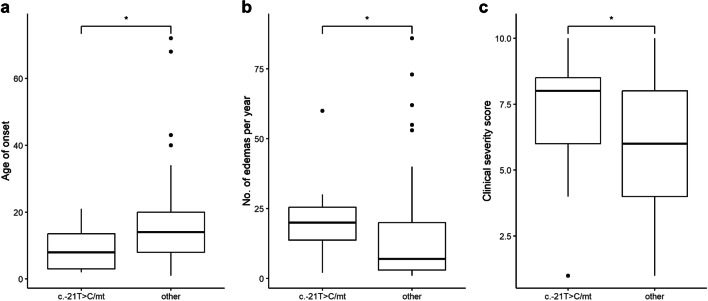Fig. 6.
Influence of the variant c.-21 T > C in trans conformation with the disease-causing variant on disease phenotype. In the analysis, two groups were compared: patients carrying the c.-21 T > C variant in trans conformation with causal variant, depicted in the graph as c.-21 T > C/mt, and patients who did not carry the c.-21 T > C variant or had this variant in cis form, depicted as other a The impact on the age of HAE onset was evaluated by comparing 12 patients carrying c.-21 T > C in trans conformation with causal variant, 148 patients that did not carry c.-21 T > C or have this variant in cis form. The presence of the variant c.-21 T > C in trans conformation was significantly associated with a lower age of HAE onset (Mann–Whitney; p = 0.024). To determine how much this result is affected by the type of causal mutation, we determined the ratio of causal mutation types in the both groups: in the group carrying the c.-21C > T variant the ratio was 1:1:4 and in the other 1:1.1:4.1 (HAE-2:missense:null). b The impact on the HAE attack frequency was evaluated by comparing 12 patients carrying c.-21 T > C in trans conformation with 150 patients that did not carry c.-21 T > C or have this variant in cis form. The presence of the variant c.-21 T > C in trans conformation was significantly associated with a higher number of attacks per year (Mann–Whitney; p = 0.018). c The association of c.-21 T > C in trans conformation with Clinical severity score was evaluated by comparing 11 patients carrying c.-21 T > C in trans conformation with 134 patients that did not carry c.-21 T > C or have this variant in cis form. The presence of the variant c.-21 T > C in trans conformation was significantly associated with a higher Clinical severity score (Mann–Whitney; p = 0.045)

